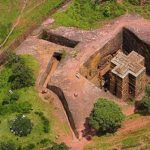Tiya Stelae
Registered as World Heritagein 1980, Tiya is among the most important of the roughly 160 archaeological sites discovered so far in the Soddo region, south of Addis Ababa. The site contains 36 monuments, including 32 carved stelae covered with symbols, most of which are difficult to decipher. They are the remains of an ancient Ethiopian culture whose age has not yet been precisely determined.
The stelae from the Soddo region, with their enigmatic configuration, are highly representative of an expression of the Ethiopian megalithic period. Soddo lies to the south of Addis Ababa, beyond the Awash River. It is remarkable because of the numerous archeological sites of the megalithic period, comprising hundreds of sculptured stelae that have been discovered there. The carved monoliths vary in size from 1 m to 5 m. their forms fall into several distinct categories: figurative composition; anthropomorphic; hemispherical or conical; simple monoliths. In the northern area are to be found stelae with depictions of swords, associated with enigmatic symbols and schematic human figures.
Among the most important of the roughly 160 archaeological sites discovered so far in the Soddo region is Tiya, lying 38 km south of the river, which is also one of the most representatives. Roughly aligned over an axis of 45 m there is a group of 33 stelae, with another group of three stelae a short distance from them. Of the 36 stelae at Tiya, 32 are sculpted with vaguely representational configurations (including the sword designs), which are for the most part difficult to decipher. One depicts the outline of a human figure in low relief.
They are the remains of an ancient Ethiopian culture the age of which has not yet been precisely determined. However, they have been interpreted as having a funerary significance, as there are tombs scattered around the stelae.
Source: Authority for Research and Conservation of Cultural Heritage





Leave a Reply